- 1Los Alamos National Laboratory, Los Alamos, NM, United States
- 2Goddard Space Flight Center, National Aeronautics and Space Administration, Greenbelt, MD, United States
The resonant right-hand instability (RHI) is often the dominant mode driven by reflected ions upstream of Earth’s quasi-parallel bow shock. In the tradition of Peter Gary, this paper further explores the right-hand instability using numerical solutions of the plasma dispersion relation and non-linear kinetic simulations, with parameters inspired by observations from NASA’s Magnetospheric Multiscale (MMS) mission. Agreement is found between the ion distributions in the particle-in-cell simulations and Magnetospheric Multiscale spacecraft data, which show the gyrophase bunching characteristic of the instability. The non-linear structures created by right-hand instability tend to be stronger when the plasma beta is lower. These structures have sizes of around 100 to 200 ion inertial lengths perpendicular to the magnetic field, presenting planet-sized disturbances to the magnetosphere. 2d and 3D hybrid particle-in-cell simulations show that modes with a range of propagation angles oblique to the magnetic field are excited, providing a ground to understand previous statistical studies of observed foreshock waves.
1 Introduction
At Earth’s bow shock, like at other collisionless shocks, ions reflected back upstream may form a beam population in velocity space. The free energy of this backstreaming ion beam drives a range of kinetic instabilities in the foreshock. For relatively tenuous and fast (compared to the background Alfven speed) ion beams traveling parallel to the magnetic field, the fastest growing linear instability is the resonant right-hand instability (RHI) (Gary, 1991). For low beam densities, this mode is a low-frequency wave carried by the background and excited by a cyclotron resonance with the beam ions. As described in another article in this collection (Winske and Wilson, 2022), Peter Gary was a pioneer in the Vlasov theory of electromagnetic ion beam instabilities in space plasmas (Gary et al., 1984; Gary et al., 1985; Gary, 1991). Gary’s work is an important piece of a large body of research on the theory and observation of RHI waves in the foreshock. Here, we re-examine properties and dynamics of the RHI using a modern hybrid particle-in-cell (PIC) code and example data from NASA’s Magnetospheric Multiscale (MMS) mission. The hybrid PIC simulations show that a finite temperature of the background decreases the amplitude of non-linear structures that develop and that a relatively broadband spectrum of modes may be excited with a range of propagation angles oblique to the local magnetic field.
Many early studies of RHI were inspired by data from the International Sun-Earth Explorer (ISEE) spacecraft. The data showed abundant wave activity in the foreshock, and it was recognized that RHI and other low-freqency modes were associated with backstreaming ions (Hoppe et al., 1981). Some effects of these waves include modifying the transport and heating of ions in the upstream plasma (Lee, 1982). The RHI in particular may also drive ultra-low frequency (ULF) waves in the 30-s period range (Watanabe and Terasawa, 1984; Greenstadt et al., 1995), which couple to particles trapped in Earth’s radiation belts. The non-linear evolution of RHI was found to be a possible driver of large-amplitude magnetic pulsations observed in the forshock (Akimoto et al., 1993). More recent simulation studies of RHI have focused on the global context of (ULF) waves and their transport into the magnetosphere (Blanco-Cano et al., 2009; Palmroth et al., 2015; Kajdič et al., 2021; Turc et al., 2022). In addition, very high-resolution field and particle data are now available from NASA’s MMS mission (Burch et al., 2016). Meanwhile, laser-driven laboratory experiments have offered a means of taking detailed measurements of ion beam instabilities in a reproducible environment (Heuer et al., 2020).
Here, we revisit RHI with a hybrid PIC code to further explore the waves and non-linear structures associated with the instability. Because earlier work focused on moderately cool beams with vthb ≲ vA (Hoshino and Terasawa, 1985; Winske and Gary, 1986; Akimoto et al., 1993) we also consider the effects of warmer beam and background ion populations. The finite temperatures moderately reduce the RHI growth rate, and they tend to reduce the amplitude of non-linear structures. We also explore the spectrum of oblique waves excited by a parallel ion beam. A statistical analysis of Cluster spacecraft data uptream of the quasi-parallel bow shock showed that the beam-driven waves have a power spectrum peaked at oblique propagation angles (Eastwood et al., 2005). This is at first glance at odds with the fact that the fastest growing mode for the beam and plasma conditions is the purely parallel propagating RHI. We find a range of oblique modes are excited in 2D and 3D simulations, consistent with solutions of the hot plasma dispersion relation. The simulations predict a typical perpendicular scale length of the non-linear RHI structures to be
2 Review of the resonant ion beam instability
In this section, we include a brief review of the resonant right-hand instability (RHI) and define the conventions we use in our analysis. The RHI is a solution of the dispersion relation for magnetized plasmas with a beam ion population traveling along the magnetic field. For the cases of interest here, the fastest growing mode is purely parallel propagating. For purely parallel modes, the relevant dispersion relation for a plasma where each species j has an isotropic Maxwellian velocity distribution is (Gary et al., 1984):
where k is the parallel wavenumber,
To study the linear growth rates of the RHI for oblique propagation including finite beam and background ion temperatures, we consider numerical solutions (Montgomery et al., 1975) of the full hot plasma dispersion relation assuming drifting Maxwellian ion distributions (see, for example the appendix of Gary, 1991). We use the open-source New Hampshire Dispersion Solver (NHDS) (Verscharen and Chandran, 2018). We work in the rest frame of the background plasma, where the background ions have no net drift. The background plasma is taken to be uniform and consisting of ions of mass mi and unit charge. We denote the background density n0 and the temperature T0. The background magnetic field is also uniform, in the positive x direction, and of strength B0. A drifting Maxwellian ion beam population is included with a density nb, temperature Tb, and a drift speed ub in the positive x direction. The Alfven Mach number of the beam is MA = ub/vA, were we normalize the drift speed to the background Alfven speed
At Earth’s bow shock, the reflected ion population is characteristically low-density (with relative beam fractions less than a few percent) and fast (with Alfven Mach numbers MA > 2). Under these conditions, the low-frequency wave spectrum is dominated by the RHI. Figure 3 shows the maximum growth rate of the RHI over a range of propagation angles for a beam of density nb/n0 = .015 and an Alfven Mach number of MA = 10, similar to typical parameters at Earth’s foreshock. The three curves show the growth rates for three different beam temperatures. The uppermost curve is a relatively cold beam, and the peak growth rate for parallel propagation agrees with the large MA approximation for cold plasmas (Gary, 1978; Weidl et al., 2019),
3 1D hybrid simulation and example event
We begin this section with an example of foreshock waves driven by reflected ions observed by NASA’s MMS mission (Burch et al., 2016). The MMS data are plotted in Figure 1, showing a fairly typical foreshock crossing in an interval upstream of the quasi-parallel bow shock on 30 January 2019. The magnetic field components in Figure 1A show a background field dominated by the radial Bx component along with large-amplitude wave fields (mainly By and Bz). The wave power is peaked near the local ion cyclotron frequency
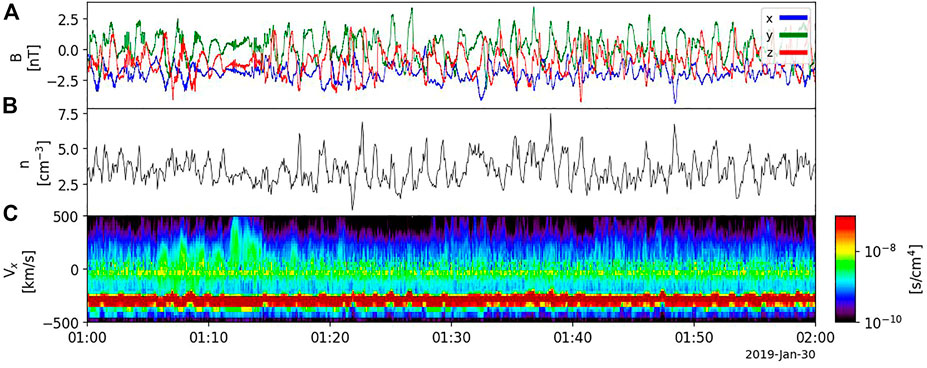
FIGURE 1. Example of RHI waves typical of the quasi-parallel foreshock as observed by the MMS2 spacecraft. The magnetic field in (A) is primarily in the x direction with large-amplitude waves in By and Bz. The total ion density it plotted in (B). The reduced ion velocity distribution in terms of vx is plotted in (C). In the spacecraft frame, the background moves in the −vx direction while the beam population is centered near vx = 0. The reflected beam ions have a relatively broad velocity spread compared to the colder solar wind population.
Because the electrons are far from resonance with the RHI and the mode frequencies are well below the electron plasma and cyclotron frequencies, hybrid numerical codes (Lipatov, 2002; Winske et al., 2003) that treat the ions as a kinetic species and the electrons as a massless neutralizing background are suitable for studying the linear and non-linear evolution of the RHI. Here, we use a hybrid version of the particle-in-cell (PIC) code VPIC (Bowers et al., 2008; Le et al., 2021; Keenan et al., 2022) to model the RHI. Numerous earlier studies of ion streaming instabilities have used similar electromagnetic hybrid PIC codes (e.g.,Winske and Quest., 1986; Hada et al., 1987; Gary and Winske, 1990; Winske and Omidi, 1992; Akimoto et al., 1993; Dubouloz and Scholer, 1995; Hellinger and Mangeney, 1999; Wang and Lin, 2003; Heuer et al., 2018; Weidl et al., 2019; Holcomb and Spitkovsky, 2019). Because the simulations in this section are 1D in the x direction, they only allow the growth of the purely parallel propagating modes, which are the fastest growing modes for the parameters we use. Note that for 2D or 3D systems with oblique modes, damping on the electrons can become more important. While this effect is included in the linear dispersion solver, it is not captured by the fluid model of the hybrid code.
As in other hybrid PIC codes, the electron model in Hybrid-VPIC takes the form of an Ohm’s law for the electric field:
where quasi-neutrality imposes n = ne = ∑sZsns (including a sum over species s of ions), the velocity ui is the charge-weighted ion flow ui = ∑sZsnsus/ne, and the current density is taken in the low-frequency approximation as μ0J = ∇ × B. We use a system of units based on the background magnetic field B0 and ion density n0, with times normalized by the cyclotron frequency ωci = eB0/mi and lengths given in terms of the ion inertial length
As described in Section 2, our 1D simulations contain a uniform background plasma of density n0 and temperature T0 (we set Ti = Te = T0) and magnetic field B0 in the x direction. To this is added a streaming population of beam ions of density nb (recall an equal number density of electrons is implicit in the quasi-neutral assumption of the hybrid code), drift velocity in the positive x direction ub, and temperature Tb. Figure 2 shows typical results from an RHI simulation with relatively cold background and beam populations. The three sets of panels in Figure 2 are at three different times over the course of simulation.
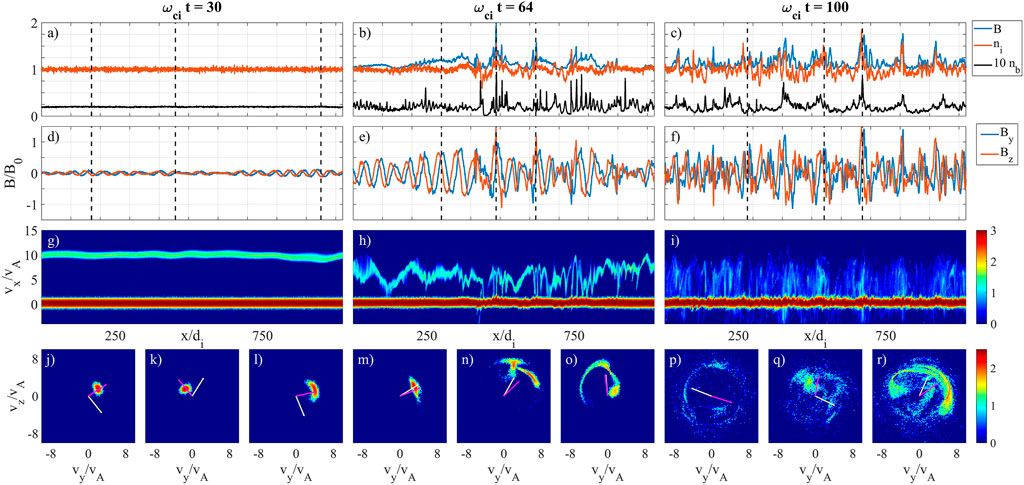
FIGURE 2. Results from 1D hybrid simulations of the resonant right-hand instability (RHI) with cold (vthi = vthb = 0.1vA) ion populations. The left panels are at early time tωci = 30, middle panels are at tωci = 64, and right panels are at tωci = 100. (A–C) Background (red) and beam (black) ion density profiles and magnetic field strength (blue). (D–F) Wave magnetic field components By and Bz. (G–I) Parallel x−vx phase space distribution of the ions, showing the dense background at vx ∼ 0 and the beam with an Alfven Mach number of MA = 10. (J–R) Beam ion distributions in the perpendicular vy−vz plane at the points marked by the vertical dashed lines in (A–C). The white lines show the direction of the perpendicular wave magnetic fields By and Bz, and the magenta lines show the direction of the bulk beam perpendicular velocity.
The leftmost panels are at time t*ωci = 30 when the RHI is nearing the end of a phase growth consistent with the linear instability. The background and beam density profiles as well as the total magnetic field magnitude in Figure 2A are relatively unperturbed. The ion phase space distribution in x−vx space in Figure 2 shows a weak modulation of the beam ions (the population centered at vx ∼ 10vA). Nevertheless, the RHI is here already strong enough to modulate the beam ions in perpendicular velocity space. The three panels of Figures 2J–L show the perpendicular velocity distribution of the beam ions in vy−vz space at the three locations marked by vertical dashed lines in Figure 2A. These distributions exhibit gyrophase bunching, with the beam ions undergoing motion in the plane perpendicular to the magnetic field. As in previous simulations and observations (Hoshino and Terasawa, 1985; Thomsen et al., 1985; Fuselier et al., 1986; Gary et al., 1986), the gyrophase bunched ions are out of phase with the wave magnetic field. In Figures 2J–L, the white line gives the direction of the wave magnetic field (By and Bz), while the black line shows the direction of the local bulk beam velocity in the y−z plane. The field and beam velocity are roughly 90° out of phase.
At later time, the RHI waves steepen into non-linear features. Non-linear structures have been observed with beam populations upstream of the bow shock, and they have been identified as shocklets (Hoppe et al., 1981; Hada et al., 1987) or magnetic pulsations (Akimoto et al., 1993). As in the earlier simulations of Akimoto et al., 1993, the non-linear pulsations driven by the RHI are characterized by correlated magnetic field strength |B| perturbations (see the blue curve in Figure 2B) that are correlated with the density n perturbations (red curve).
Thermal velocity spreads of the background and beam ions that are not large compared to the relative drift speed do not qualitatively affect the linear properties of the RHI, though the finite temperatures moderately reduce the growth rates. The non-linear features that develop, however, are weaker in amplitude in our simulations with higher beam and background temperatures. We show example data from a simulation with a beam thermal spread vthb = 3vA and background thermal speed of vth0 = vA in Figure 3. For cold beams ions as in Figure 2, practically all of the beam ions can become bunched where the RHI waves steepen. In addition to bunching in gyrophase angle, these resonant beam ions can be dramatically slowed down in the parallel direction, even locally coming to a stop in the background frame (see Figure 2H). For hot beams that are more diffuse in velocity space, on the other hand, a relatively smaller fraction of the beams ions are near exact resonance with the RHI mode. As a result, a smaller fraction of the beam ions in Figure 3H are slowed by the wave fields. This results in a much less spiky beam ion density profile in Figure 3B than for the cold ions case. Furthermore, because the RHI couples to compressional modes, the higher background pressure weakens the amplitude of the non-linear features. For even higher background temperatures with vth0 = 4vA (not plotted), there are no discernible pulsations or spikes in the density or magnetic field profiles.
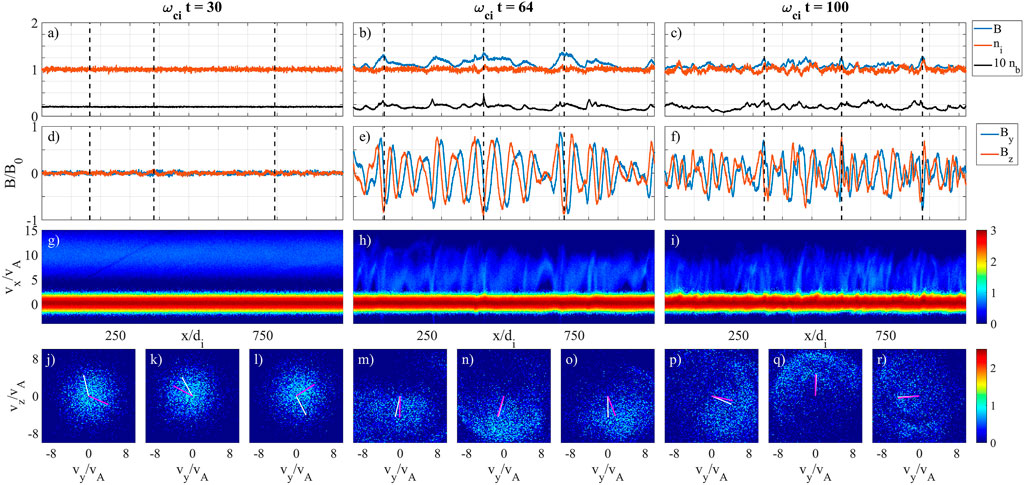
FIGURE 3. Similar plots as in Figure 2, but with warm background (
The beam ions do display strong gyrophase bunching in perpendicular velocity space, although the non-linear structures that develop are relatively weak for the warmer beam and background temperatures (see Figure 3). We display side-by-side in Figure 4 ion vy velocity distributions from the MMS event and from the Hybrid-VPIC simulation of Figure 3. The MMS data in Figure 4A show the vy distribution of ions over time, which may be taken as a proxy for distance x because the waves rapidly cross the spacecraft. A distribution in x−vy phase space from the hybrid PIC model is displayed in Figure 3B covering a range with a similar wave phase and amplitude as the MMS data. Note that
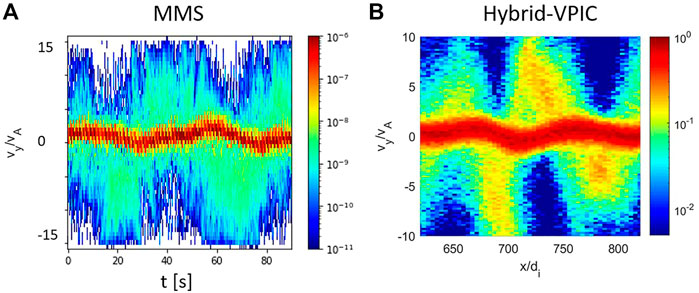
FIGURE 4. Ion velocity distributions in vy from (A) the MMS event displayed in Figure 1 in an interval starting near time 01:05 and (B) from the hybrid PIC simulation with warm beam (vthb = 3vA) and background (vth0 = vA)) ions of Figure 3 at t = 40/ωci. In (A), the time t may be considered a proxy for the position x in (B) as the solar wind passes the spacecraft at the solar wind drift speed of 300 km/s ∼ 10vA. The correspondence is 50 s ∼ 100 di.
4 2D and 3D hybrid simulations
In this section, we consider 2D and 3D hybrid simulations to study the evolution of the RHI in multiple spatial dimensions. The 2D or 3D geometry allows the development of a spectrum of modes with k vectors oblique to the magnetic field. As visible in Figure 5, the RHI growth rate is relatively insensitive to the propagation angle out to
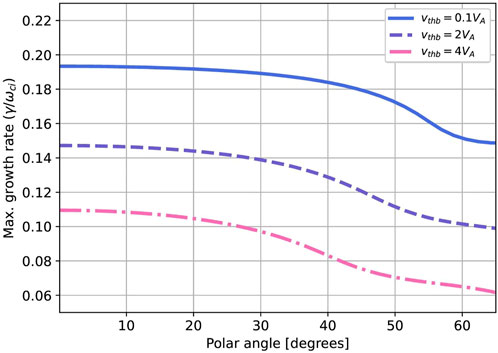
FIGURE 5. Growth rate of the RHI for oblique propagation as a function of the angle between the wave vector k and the background magnetic field for nb/n0 = .015 and MA = 10. Note that the growth rate is very similar for angles ≲35°. The three curves show the growth rate for different beam temperatures with thermal speeds indicated in the legend.
To examine the spectrum of oblique modes, we consider a 2D simulation in the x−z plane of a uniform beam, building on early hybrid simulation work on 2D ion-ion beam instability growth (Winske and Quest, 1986). The simulation domain is of size Lx × Lz = 1024 di × 1024 di = 2048 × 2048 cells, the background (vth0 = vA) and beam (nb/n0 = .02, MA = 10, vthb = 4.3vA) ion populations are each sampled by 400 particles per cell, and the time step is δt = .01/Ωci. In Figure 6, we compare the growth rates predicted by numerical solution of the hot plasma dispersion relation in (a) to the growth rates extracted directly from the hybrid PIC simulation in (b). The growth rate in each case is plotted in terms of the parallel (k‖ and perpendicular k⊥ wave numbers. The peak growth rate occurs for parallel propagation and corresponds to the usual RHI. Consistent with Figure 5, there is a relatively broad range of oblique wave vectors with growth rates very close to the maximum. Because of this, a wide spectrum of waves with varying propagation angles is excited. The modes plotted are all almost exactly right circularly polarized. The real frequency increases by a factor of few beyond propagation angles of 40°, and those more perpendicular modes may connect to a different wave branch.
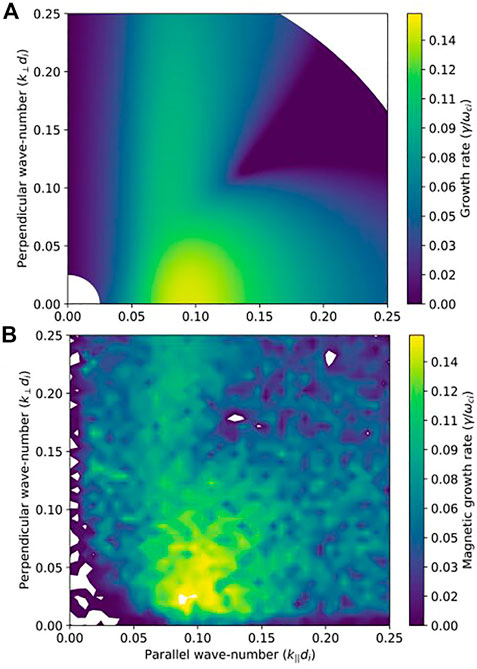
FIGURE 6. (A) Growth rate computed using the NHDS Verscharen and Chandran, (2018) as a function of parallel (k‖di) and perpendicular (
The magnetic field and density structures that develop after the RHI saturates are very similar in 2D and 3D. Figure 7 shows comparisons of (a, c) the magnetic field component Bz and the (b, d) the plasma density between a 2D and a corresponding 3D hybrid simulation. These simulations are similar to the above simulation, but with a domain of size of L = 512di = 512 cells in each spatial dimension. The wide spectrum of unstable oblique modes produces magnetic fluctuations with oblique phase fronts. To quantify this effect, we show in Figure 8 a Fourier power spectrum of the wave magnetic field component Bz plotted in Figure 7A. The symmetry of the spectrum for k going to −k is simply a result of the Fourier transform of the real function Bz. The peak in the power spectrum is at kxdi ∼ .1, corresponding to a characteristic wavelength of
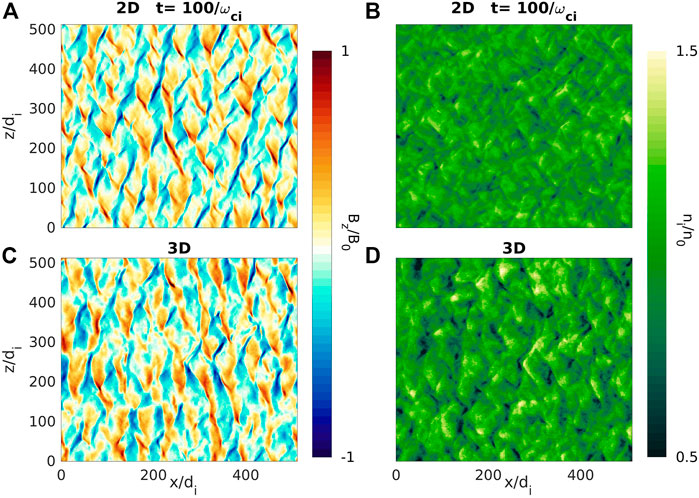
FIGURE 7. Comparison between (A, B) 2D and (C, D) 3D simulations. Left panels show Bz magnetic field component and right panels show density fluctuations in two runs with identical parameters (nb/n0 = .02, MA = 10, βi = 1, βb = 4.5) at a late phase after the resonant mode has saturated.
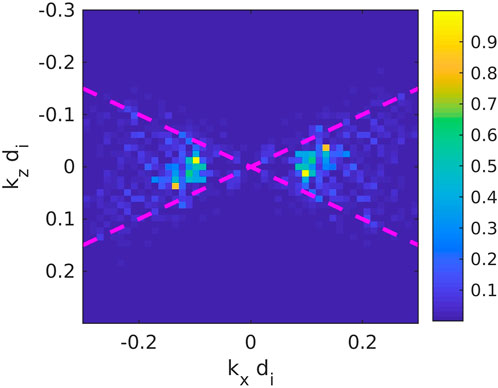
FIGURE 8. Power spectrum |Bz(kx, kz)|2 of the magnetic field plotted in Figure 7A. The dashed magenta lines indicate where the propagation angle is 30° with respect to the background field Bx.
As another way of displaying the parallel and perpendicular structure of the saturated magnetic field fluctuations, we plot cuts of the magnetic field components in Figure 9 along the (a, c) parallel or x direction and the (b, d) perpendicular or z direction. Again, the characteristic parallel wavelengths here are
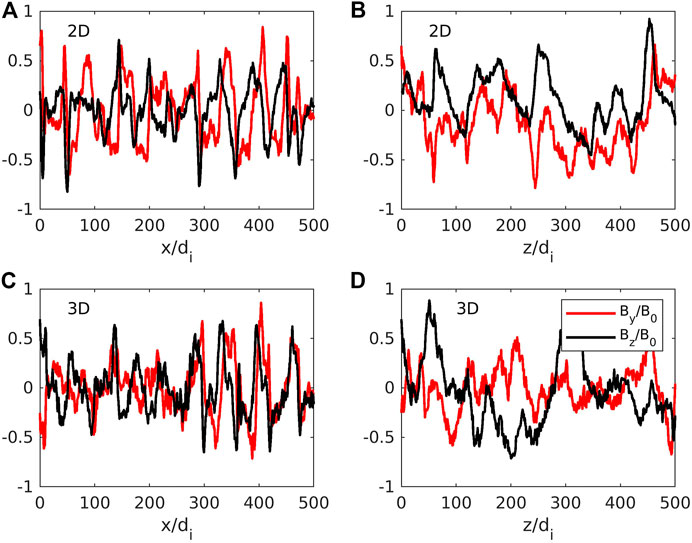
FIGURE 9. Comparison between (A, B) 2D and (C, D) 3D simulations. Left panels show Bz magnetic field component and right panels show density fluctuations in runs with identical parameters (nb/n0 = .02, MA = 10, βi = 1, βb = 4.5) at a late phase after the resonant mode has saturated. The 2D and 3D simulations have similar characteristic parallel and perpendicular length scales.
5 Summary discussion
Using a modern hybrid PIC code, we revisited the resonant right-hand instability (RHI), which is the dominant electromagnetic ion beam instability for parallel-propagating ion beams that are relatively fast and tenuous. The parameters for the simulations were inspired by MMS observations of typical quasi-parallel foreshock fluctuations. RHI is prevalent upstream of the quasi-parallel region of Earth’s bow shock and has been the subject of a large number of previous observational and theoretical studies, including important early works by Peter Gary (Gary et al., 1984; Gary et al., 1985; Gary et al., 1986; Gary and Winske, 1990; Gary, 1991). Here, we focused on properties of the RHI related to finite temperature effects and oblique propagation. The hybrid simulations show that warm (β > 1) background and beam ion populations produce less steep non-linear features than the cold populations assumed in many previous studies. Note the RHI itself scatters reflected beam ions effectively, and it is possible that the RHI scatters an initially cooler beam into the more diffuse beam with a larger velocity spread observed by MMS. In any case, a high-beta background plasma requires additional energy to be compressed, which explains the weaker non-linear compressional features observed in simulations with high plasma beta (particularly β ≫ 1, which is not typical of the solar wind at Earth’s foreshock).
Multi-dimensional (2D and 3D) hybrid simulations demonstrated that a wide spectrum of oblique modes is excited, in agreement with growth rates predicted by numerical solution of the hot plasma dispersion relation. The RHI instability growth rate is a fairly flat function of propagation angle out to
Data availability statement
The simulation data for this study can be reproduced by running the open-source Hybrid-VPIC code branch found at https://github.com/lanl/vpic-kokkos/tree/hybridVPIC. MMS datasets are retained and available through https://lasp.colorado.edu/mms/sdc/public/.
Author contributions
AL conceived the paper idea and formulated the investigation with L-JC. AL ran simulations, analyzed data, and prepared the manuscript. L-JC prepared figures of MMS data. BW ran simulations and prepared figures. BK analyzed simulation data, ran the NHDS code, and prepared figures. All authors discussed the results and reviewed the manuscript.
Funding
This work was supported by the Los Alamos LDRD program and by NASA’s Magnetospheric Multiscale Mission. Simulations used LANL Institutional Computing resources.
Conflict of interest
The authors declare that the research was conducted in the absence of any commercial or financial relationships that could be construed as a potential conflict of interest.
Publisher’s note
All claims expressed in this article are solely those of the authors and do not necessarily represent those of their affiliated organizations, or those of the publisher, the editors and the reviewers. Any product that may be evaluated in this article, or claim that may be made by its manufacturer, is not guaranteed or endorsed by the publisher.
References
Akimoto, K., Winske, D., Gary, S., and Thomsen, M. (1993). Nonlinear evolution of electromagnetic ion beam instabilities. J. Geophys. Res. Space Phys. 98, 1419–1433. doi:10.1029/92ja02345
Blanco-Cano, X., Omidi, N., and Russell, C. (2009). Global hybrid simulations: Foreshock waves and cavitons under radial interplanetary magnetic field geometry. J. Geophys. Res. Space Phys. 114, 13406. doi:10.1029/2008ja013406
Bowers, K. J., Albright, B., Yin, L., Bergen, B., and Kwan, T. (2008). Ultrahigh performance three-dimensional electromagnetic relativistic kinetic plasma simulation. Phys. Plasmas 15, 055703. doi:10.1063/1.2840133
Burch, J., Torbert, R., Phan, T., Chen, L. J., Moore, T., Ergun, R., et al. (2016). Electron-scale measurements of magnetic reconnection in space. Science 352, aaf2939. doi:10.1126/science.aaf2939
Chen, L. J., Halekas, J., Wang, S., DiBraccio, G. A., Romanelli, N., Ng, J., et al. (2022). Solitary magnetic structures developed from gyro-resonance with solar wind ions at Mars and Earth. Geophys. Res. Lett. 49, e2021GL097600. doi:10.1029/2021gl097600
Daughton, W., and Gary, S. P. (1998). Electromagnetic proton/proton instabilities in the solar wind. J. Geophys. Res. Space Phys. 103, 20613–20620. doi:10.1029/98ja01385
Dubouloz, N., and Scholer, M. (1995). Two-dimensional simulations of magnetic pulsations upstream of the Earth’s bow shock. J. Geophys. Res. Space Phys. 100, 9461–9474. doi:10.1029/94ja03239
Eastwood, J., Balogh, A., Lucek, E., Mazelle, C., and Dandouras, I. (2005). Quasi-monochromatic ulf foreshock waves as observed by the four-spacecraft cluster mission: 2. Oblique propagation. J. Geophys. Res. Space Phys. 110, A11220. doi:10.1029/2004ja010618
Fuselier, S., Thomsen, M., Gary, S., Bame, S., Russell, C., and Parks, G. (1986). The phase relationship between gyrophase-bunched ions and mhd-like waves. Geophys. Res. Lett. 13, 60–63. doi:10.1029/gl013i001p00060
Gary, S. P. (1991). Electromagnetic ion/ion instabilities and their consequences in space plasmas: A review. Space Sci. Rev. 56, 373–415. doi:10.1007/bf00196632
Gary, S. P., Madland, C. D., and Tsurutani, B. T. (1985). Electromagnetic ion beam instabilities: Ii. Phys. fluids 28, 3691–3695. doi:10.1063/1.865101
Gary, S. P., Smith, C. W., Lee, M. A., Goldstein, M. L., and Forslund, D. W. (1984). Electromagnetic ion beam instabilities. Phys. fluids 27, 1852–1862. doi:10.1063/1.864797
Gary, S. P. (1978). The electromagnetic ion beam instability and energy loss of fast alpha particles. Nucl. fusion 18, 327–334. doi:10.1088/0029-5515/18/3/003
Gary, S. P., Thomsen, M. F., and Fuselier, S. A. (1986). Electromagnetic instabilities and gyrophase-bunched particles. Phys. fluids 29, 531–535. doi:10.1063/1.865441
Gary, S. P., and Winske, D. (1990). Computer simulations of electromagnetic instabilities in the plasma sheet boundary layer. J. Geophys. Res. Space Phys. 95, 8085–8094. doi:10.1029/ja095ia06p08085
Greenstadt, E., Le, G., and Strangeway, R. (1995). Ulf waves in the foreshock. Adv. Space Res. 15, 71–84. doi:10.1016/0273-1177(94)00087-h
Hada, T., Kennel, C., and Terasawa, T. (1987). Excitation of compressional waves and the formation of shocklets in the Earth’s foreshock. J. Geophys. Res. Space Phys. 92, 4423–4435. doi:10.1029/ja092ia05p04423
Hellinger, P., and Mangeney, A. (1999). Electromagnetic ion beam instabilities: Oblique pulsations. J. Geophys. Res. Space Phys. 104, 4669–4680. doi:10.1029/1998ja900157
Heuer, P. V., Weidl, M. S., Dorst, R. S., Schaeffer, D. B., Tripathi, S. K., Vincena, S., et al. (2020). Laboratory observations of ultra-low-frequency analog waves driven by the right-hand resonant ion beam instability. Astrophysical J. Lett. 891, L11. doi:10.3847/2041-8213/ab75f4
Heuer, P., Weidl, M., Dorst, R., Schaeffer, D., Bondarenko, A., Tripathi, S., et al. (2018). Observations of a field-aligned ion/ion-beam instability in a magnetized laboratory plasma. Phys. Plasmas 25, 032104. doi:10.1063/1.5017637
Holcomb, C., and Spitkovsky, A. (2019). On the growth and saturation of the gyroresonant streaming instabilities. Astrophysical J. 882, 3. doi:10.3847/1538-4357/ab328a
Hoppe, M., Russell, C., Frank, L., Eastman, T., and Greenstadt, E. (1981). Upstream hydromagnetic waves and their association with backstreaming ion populations: Isee 1 and 2 observations. J. Geophys. Res. Space Phys. 86, 4471–4492. doi:10.1029/ja086ia06p04471
Hoshino, M., and Terasawa, T. (1985). Numerical study of the upstream wave excitation mechanism: 1. Nonlinear phase bunching of beam ions. J. Geophys. Res. Space Phys. 90, 57–64. doi:10.1029/ja090ia01p00057
Kajdič, P., Pfau-Kempf, Y., Turc, L., Dimmock, A. P., Palmroth, M., Takahashi, K., et al. (2021). Ulf wave transmission across collisionless shocks: 2.5 d local hybrid simulations. J. Geophys. Res. Space Phys. 126, e2021JA029283. doi:10.1029/2021ja029283
Keenan, B. D., Le, A., Winske, D., Stanier, A., Wetherton, B., Cowee, M., et al. (2022). Hybrid particle-in-cell simulations of electromagnetic coupling and waves from streaming burst debris. Phys. Plasmas 29, 012107. doi:10.1063/5.0075482
Kucharek, H., Scholder, M., and Matthews, A. (2000). Three-dimensional simulation of the electromagnetic ion/ion beam instability: Cross field diffusion. Nonlinear Process. Geophys. 7, 167–172. doi:10.5194/npg-7-167-2000
Le, A., Daughton, W., Karimabadi, H., and Egedal, J. (2016). Hybrid simulations of magnetic reconnection with kinetic ions and fluid electron pressure anisotropy. Phys. Plasmas 23, 032114. doi:10.1063/1.4943893
Le, A., Winske, D., Stanier, A., Daughton, W., Cowee, M., Wetherton, B., et al. (2021). Astrophysical explosions revisited: Collisionless coupling of debris to magnetized plasma. J. Geophys. Res. Space Phys. 126, e2021JA029125. doi:10.1029/2021ja029125
Lee, M. A. (1982). Coupled hydromagnetic wave excitation and ion acceleration upstream of the Earth’s bow shock. J. Geophys. Res. Space Phys. 87, 5063–5080. doi:10.1029/ja087ia07p05063
Lipatov, A. S. (2002). The hybrid multiscale simulation technology: An introduction with application to astrophysical and laboratory plasmas. Berlin, Germany: Springer Science & Business Media.
Montgomery, M. D., Gary, S. P., Forslund, D., and Feldman, W. (1975). Electromagnetic ion-beam instabilities in the solar wind. Phys. Rev. Lett. 35, 890. doi:10.1103/physrevlett.35.890.3
Palmroth, M., Archer, M., Vainio, R., Hietala, H., Pfau-Kempf, Y., Hoilijoki, S., et al. (2015). Ulf foreshock under radial imf: Themis observations and global kinetic simulation vlasiator results compared. J. Geophys. Res. Space Phys. 120, 8782–8798. doi:10.1002/2015ja021526
Stanier, A., Chacon, L., and Le, A. (2020). A cancellation problem in hybrid particle-in-cell schemes due to finite particle size. J. Comput. Phys. 420, 109705. doi:10.1016/j.jcp.2020.109705
Strumik, M., Roytershteyn, V., Karimabadi, H., Stasiewicz, K., Grzesiak, M., and Przepiórka, D. (2015). Identification of the dominant ulf wave mode and generation mechanism for obliquely propagating waves in the Earth’s foreshock. Geophys. Res. Lett. 42, 5109–5116. doi:10.1002/2015gl064915
Thomsen, M., Gosling, J., Bame, S., and Russell, C. (1985). Gyrating ions and large-amplitude monochromatic mhd waves upstream of the Earth’s bow shock. J. Geophys. Res. Space Phys. 90, 267–273. doi:10.1029/ja090ia01p00267
Turc, L., Zhou, H., Tarvus, V., Ala-Lahti, M., Battarbee, M., Pfau-Kempf, Y., et al. (2022). A global view of pc3 wave activity in near-Earth space: Results from hybrid-vlasov simulations. Front. Astronomy Space Sci. 9, 989369. doi:10.3389/fspas.2022.989369
Verscharen, D., and Chandran, B. (2018). Nhds: The New Hampshire dispersion relation solver. Res. Notes AAS 2, 13. doi:10.3847/2515-5172/aabfe3
Wang, X., and Lin, Y. (2003). Generation of nonlinear alfvén and magnetosonic waves by beam–plasma interaction. Phys. Plasmas 10, 3528–3538. doi:10.1063/1.1599359
Watanabe, Y., and Terasawa, T. (1984). On the excitation mechanism of the low-frequency upstream waves. J. Geophys. Res. Space Phys. 89, 6623–6630. doi:10.1029/ja089ia08p06623
Weidl, M. S., Winske, D., and Niemann, C. (2019). Three regimes and four modes for the resonant saturation of parallel ion-beam instabilities. Astrophysical J. 873, 57. doi:10.3847/1538-4357/ab0462
Winske, D., and Gary, S. (1986). Electromagnetic instabilities driven by cool heavy ion beams. J. Geophys. Res. Space Phys. 91, 6825–6832. doi:10.1029/ja091ia06p06825
Winske, D., and Omidi, N. (1992). Electromagnetic ion/ion cyclotron instability: Theory and simulations. J. Geophys. Res. Space Phys. 97, 14779–14799. doi:10.1029/92ja00902
Winske, D., and Quest, K. (1986). Electromagnetic ion beam instabilities: Comparison of one-and two-dimensional simulations. J. Geophys. Res. Space Phys. 91, 8789–8797. doi:10.1029/ja091ia08p08789
Winske, D., and Wilson, L. B. (2022). Linear theory of electromagnetic ion beam instabilities in the Earth’s forshock: Peter gary’s contributions (1981–1991). Front. Astronomy Space Sci. 9, 899642. doi:10.3389/fspas.2022.899642
Keywords: foreshock, instability, oblique, electromagnetic, ions, bow shock
Citation: Le A, Chen L-J, Wetherton B, Keenan B and Stanier A (2023) Oblique propagation and temperature effects on the resonant right-hand ion beam instability. Front. Astron. Space Sci. 9:1100472. doi: 10.3389/fspas.2022.1100472
Received: 16 November 2022; Accepted: 21 December 2022;
Published: 10 January 2023.
Edited by:
Charles William Smith, University of New Hampshire, United StatesReviewed by:
Daniel Verscharen, University College London, United KingdomMourad Djebli, USTHB, Algeria
Copyright © 2023 Le, Chen, Wetherton, Keenan and Stanier. This is an open-access article distributed under the terms of the Creative Commons Attribution License (CC BY). The use, distribution or reproduction in other forums is permitted, provided the original author(s) and the copyright owner(s) are credited and that the original publication in this journal is cited, in accordance with accepted academic practice. No use, distribution or reproduction is permitted which does not comply with these terms.
*Correspondence: Ari Le, YXJpbGVAbGFubC5nb3Y=
 Ari Le
Ari Le Li-Jen Chen2
Li-Jen Chen2 Blake Wetherton
Blake Wetherton